MICROSCOPE-ANTIQUES.COM © 2013-16.
This page last revised: April 29, 2016
LIEBERKUHN 'COMPASS' MICROSCOPE:
c. 1800, unsigned
| DESCRIPTION | HISTORY |

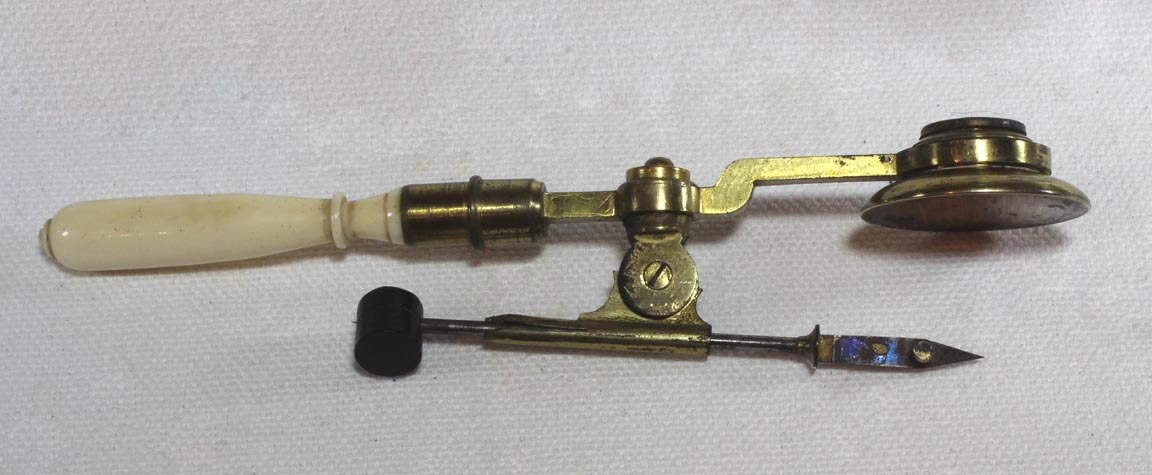
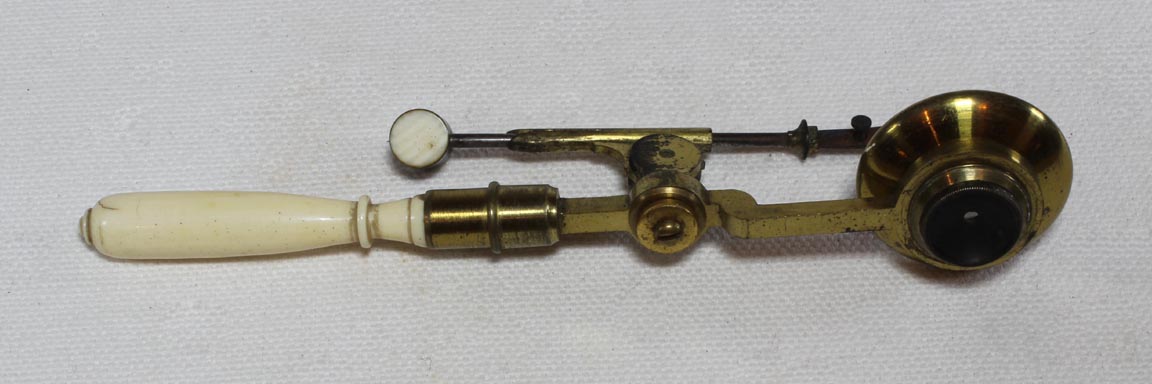
| DESCRIPTION | HISTORY |



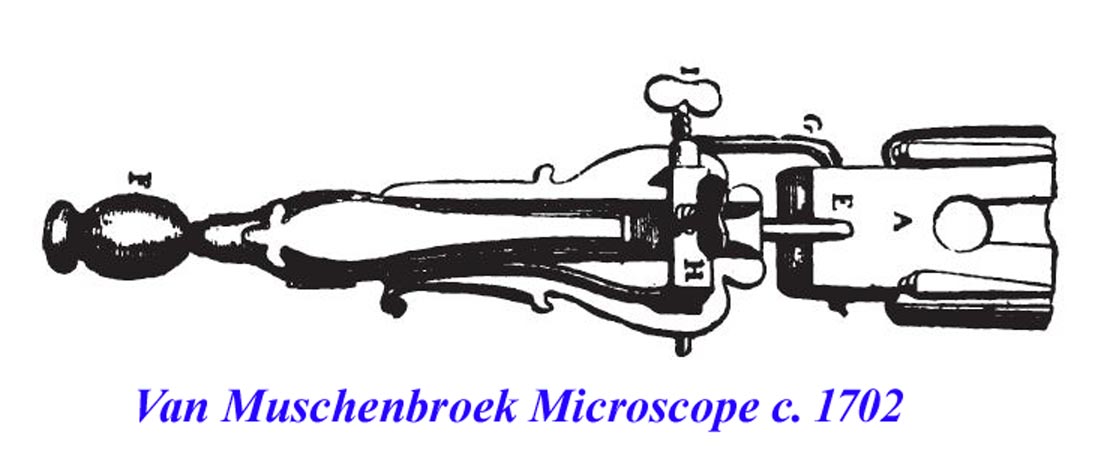 The 'compass' microscope gets its name from the joint of the
drawing instrument, though it was never called that during the years it was produced. One could argue about the origin of this type of instrument, for some of its features may date back to Van Leeuwenhoek's time. Gerard Turner has called Van Muschenbroek's high power handheld microscope a 'compass' microscope, but I would let the reader judge for themselves. It seems the only similarities to the first examples of what we would now call 'compass microscopes' are the fact that it is handheld, and that the focusing is adjustable via a screw acting on a hinged arm. This type of focusing mechanism, that is a screw acting against an arm given tension by a spring, was used on the earliest examples of compass microscope, and this may the the reason that Turner related the two types. Many authors have noted that James Wilson, 'popularizer' of the Screwbarrel microscope, may
be the first to be credited with what we now call the 'compass' design. It is notable however that the Muschenbroek high power model and Wilson's first version of compass microscope were first made at about the same time.
The 'compass' microscope gets its name from the joint of the
drawing instrument, though it was never called that during the years it was produced. One could argue about the origin of this type of instrument, for some of its features may date back to Van Leeuwenhoek's time. Gerard Turner has called Van Muschenbroek's high power handheld microscope a 'compass' microscope, but I would let the reader judge for themselves. It seems the only similarities to the first examples of what we would now call 'compass microscopes' are the fact that it is handheld, and that the focusing is adjustable via a screw acting on a hinged arm. This type of focusing mechanism, that is a screw acting against an arm given tension by a spring, was used on the earliest examples of compass microscope, and this may the the reason that Turner related the two types. Many authors have noted that James Wilson, 'popularizer' of the Screwbarrel microscope, may
be the first to be credited with what we now call the 'compass' design. It is notable however that the Muschenbroek high power model and Wilson's first version of compass microscope were first made at about the same time. 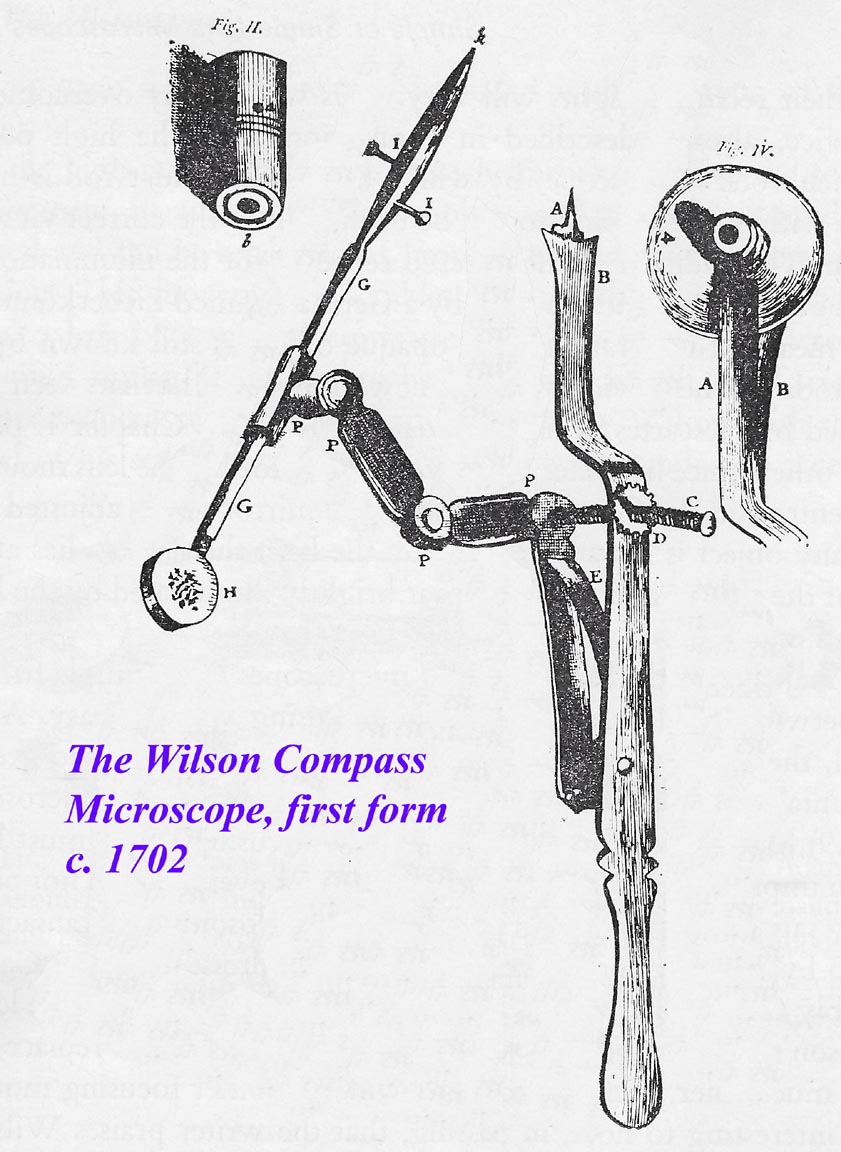 If one goes to the earliest description and illustrations of Wilson, one finds in 1702, his earliest known form (left). In this form, the compass
microscope had a single flat plate of brass as its main support
including the 'handle'. The different lenses (higher and lower
power) attached to a spike, similar to some earlier instruments. A springy piece of metal on the other side of the lens, noted as 'B' in the figure, served to hold or steady the lens in place. This microscope was criticized in the literature of its time for its coarse threads for focusing, and its
flimsy design, but the quality of its lenses, was commended. As of 2016, the author knows of the existance of only one example of this form of compass microscope in a private collection.
One should keep in mind that the idea of using a screw to adjust the focus of a handheld instrument was well known before this, having been used in some fashion by Van Leeuwenhoek and likely others. There is a replica of Van Leeuwenhoek's instrument on this web site.
If one goes to the earliest description and illustrations of Wilson, one finds in 1702, his earliest known form (left). In this form, the compass
microscope had a single flat plate of brass as its main support
including the 'handle'. The different lenses (higher and lower
power) attached to a spike, similar to some earlier instruments. A springy piece of metal on the other side of the lens, noted as 'B' in the figure, served to hold or steady the lens in place. This microscope was criticized in the literature of its time for its coarse threads for focusing, and its
flimsy design, but the quality of its lenses, was commended. As of 2016, the author knows of the existance of only one example of this form of compass microscope in a private collection.
One should keep in mind that the idea of using a screw to adjust the focus of a handheld instrument was well known before this, having been used in some fashion by Van Leeuwenhoek and likely others. There is a replica of Van Leeuwenhoek's instrument on this web site. 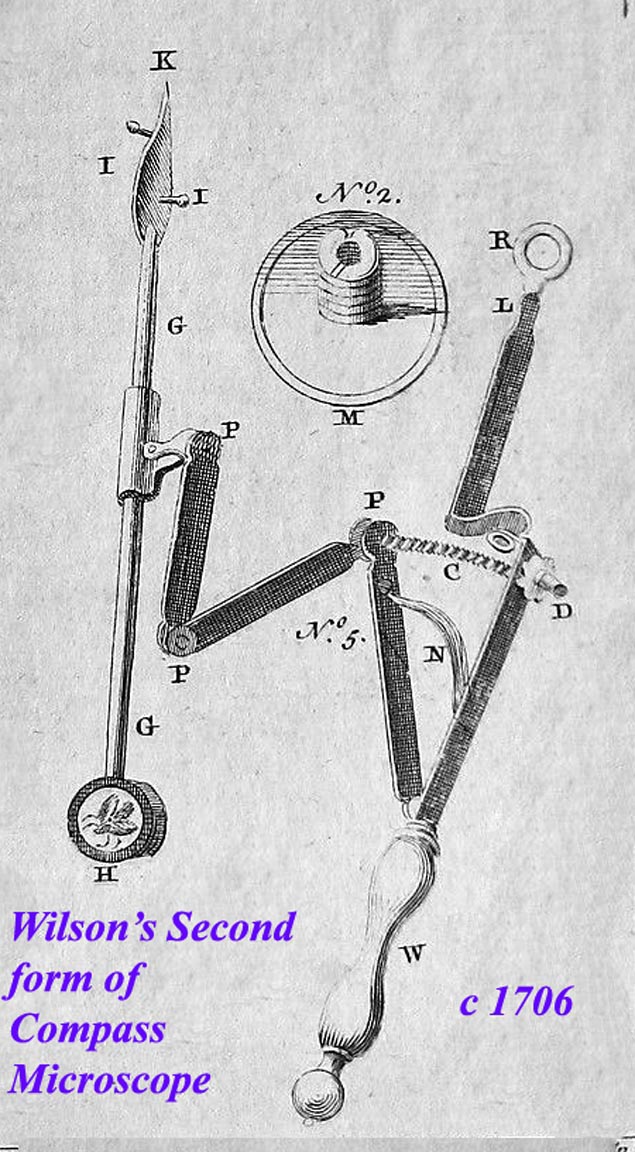 In
Wilson's second form of compass microscope, described only four years
after his first, the design had changed to include a turned brass
handle (which could also be used with the screwbarrel microscope), and
the lenses now screwed in to the instrument instead of being stuck on a spike. Examples of this design also are known today; one can be seen imaged from the Giordano Collection in the Singular Beauty Catalog.
In
Wilson's second form of compass microscope, described only four years
after his first, the design had changed to include a turned brass
handle (which could also be used with the screwbarrel microscope), and
the lenses now screwed in to the instrument instead of being stuck on a spike. Examples of this design also are known today; one can be seen imaged from the Giordano Collection in the Singular Beauty Catalog.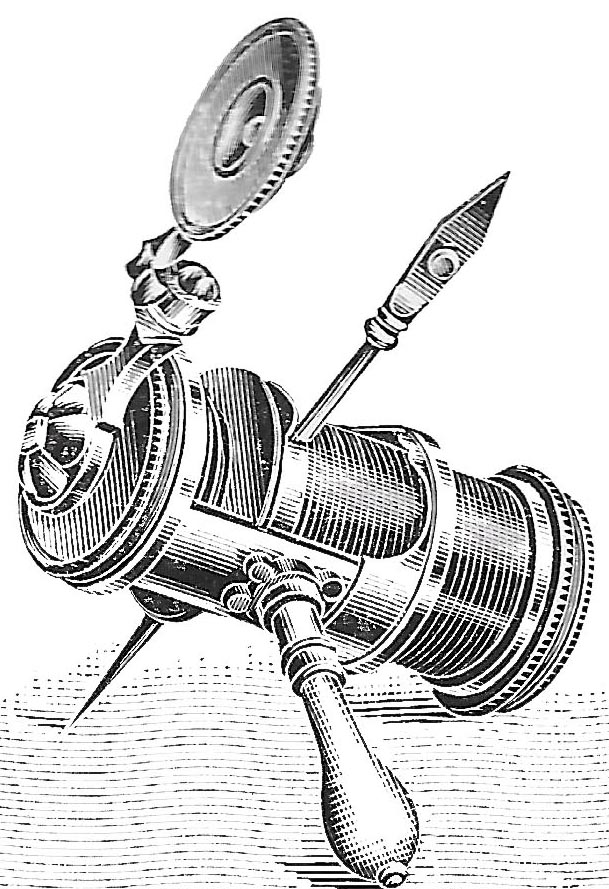 About
1710, Wilson started to produce an opaque accessory(left) for the
screwbarrel microscope which then made it unnecessary to include a compass
microscope with it. This type of accessory was copied by the other
makers and thus became quite common.
About
1710, Wilson started to produce an opaque accessory(left) for the
screwbarrel microscope which then made it unnecessary to include a compass
microscope with it. This type of accessory was copied by the other
makers and thus became quite common. 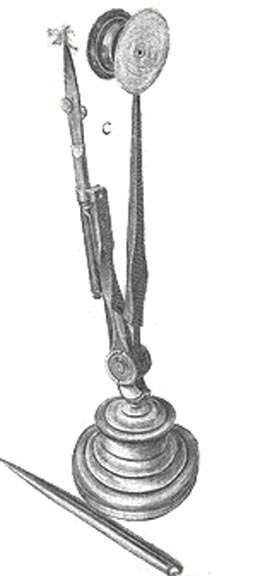 Although the 'compass microscope' was around from the earliest years of the 18th
century, compass microscopes that more closely resembled a compass were
produced a little later, some handheld and some on some kind of base.
The example shown to the left has been dated to the 2nd quarter of the 18th century.
Although the 'compass microscope' was around from the earliest years of the 18th
century, compass microscopes that more closely resembled a compass were
produced a little later, some handheld and some on some kind of base.
The example shown to the left has been dated to the 2nd quarter of the 18th century. 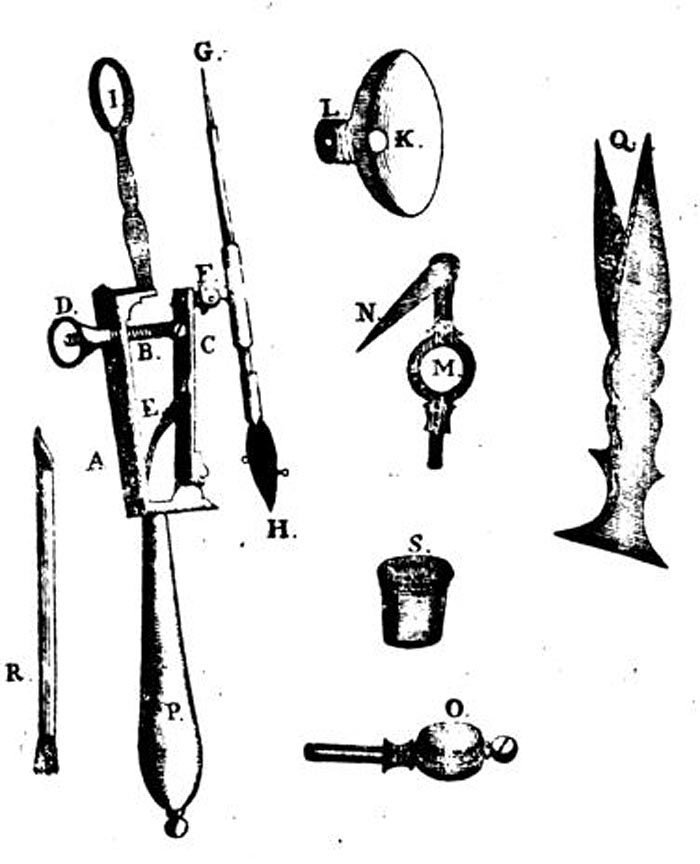 The
visualization of opaque objects with a microscope becomes a challenge
particularly as magnification is increased and therefore focal length
is decreased. This limits the amount of illumination the object can
receive that would still be reflected in the direction of the eye. One way around this is to construct a reflector around the lens facing the object. This reflector
is designed so that, at the focal length of the lens, the reflector
focuses light from beyond the object back down onto the object. This
idea dates back to Descartes in 1637 and also to Van Leeuwenhoek. The idea was not pursued much however until Johannes Lieberkuhn popularized the idea in Europe and then England in about 1738. It was John Cuff who was apparently the first in England to latch on to this idea and by the early 1740's was producing an improved compass microscope which is pictured to left and he called his
'Microscope for Opake Objects'. The instrument has a hinged focusing system with a spring to hold it steady against the adjusting screw. Cuff apparently sold these in a
kit along with the Screwbarrel microscope, and also in a kit of their own, usually with several different Lieberkuhn lenses.
Cuff also adapted the Lieberkuhn to his new improved type of compound microscope that now bears his name-the 'Cuff-type' Microscope. He did this by attaching the reflector to the end of a tube which fit around the nosepiece. Following Cuff's lead, English makers proceeded to use the Lieberkuhn reflector on many handheld microscopes. Famous makers likely included
Benjamin Martin, George Adams, and later, W & S Jones. The Cuff-designed screw fine focusing mechanism on
the early versions was carried on in some examples by some makers like Adams. Soon however,
versions without a screw fine focus were made, depending mainly on friction joints for focusing, and the example at the top of this page is one of those.
The
visualization of opaque objects with a microscope becomes a challenge
particularly as magnification is increased and therefore focal length
is decreased. This limits the amount of illumination the object can
receive that would still be reflected in the direction of the eye. One way around this is to construct a reflector around the lens facing the object. This reflector
is designed so that, at the focal length of the lens, the reflector
focuses light from beyond the object back down onto the object. This
idea dates back to Descartes in 1637 and also to Van Leeuwenhoek. The idea was not pursued much however until Johannes Lieberkuhn popularized the idea in Europe and then England in about 1738. It was John Cuff who was apparently the first in England to latch on to this idea and by the early 1740's was producing an improved compass microscope which is pictured to left and he called his
'Microscope for Opake Objects'. The instrument has a hinged focusing system with a spring to hold it steady against the adjusting screw. Cuff apparently sold these in a
kit along with the Screwbarrel microscope, and also in a kit of their own, usually with several different Lieberkuhn lenses.
Cuff also adapted the Lieberkuhn to his new improved type of compound microscope that now bears his name-the 'Cuff-type' Microscope. He did this by attaching the reflector to the end of a tube which fit around the nosepiece. Following Cuff's lead, English makers proceeded to use the Lieberkuhn reflector on many handheld microscopes. Famous makers likely included
Benjamin Martin, George Adams, and later, W & S Jones. The Cuff-designed screw fine focusing mechanism on
the early versions was carried on in some examples by some makers like Adams. Soon however,
versions without a screw fine focus were made, depending mainly on friction joints for focusing, and the example at the top of this page is one of those.